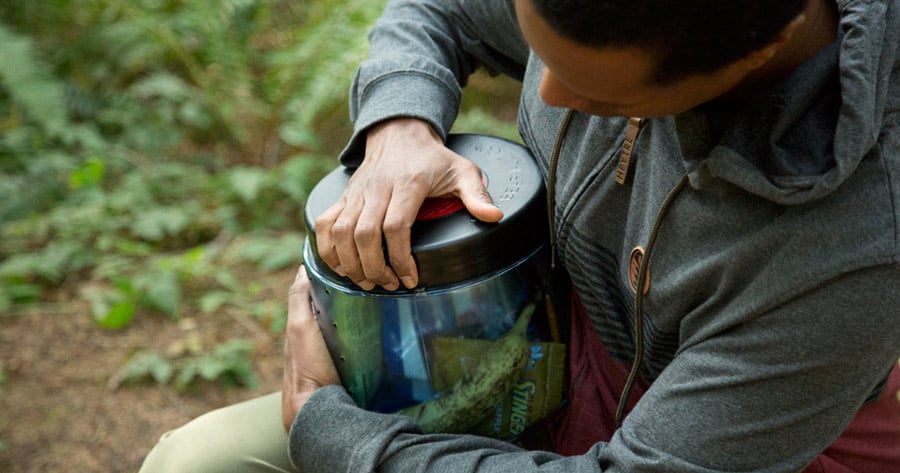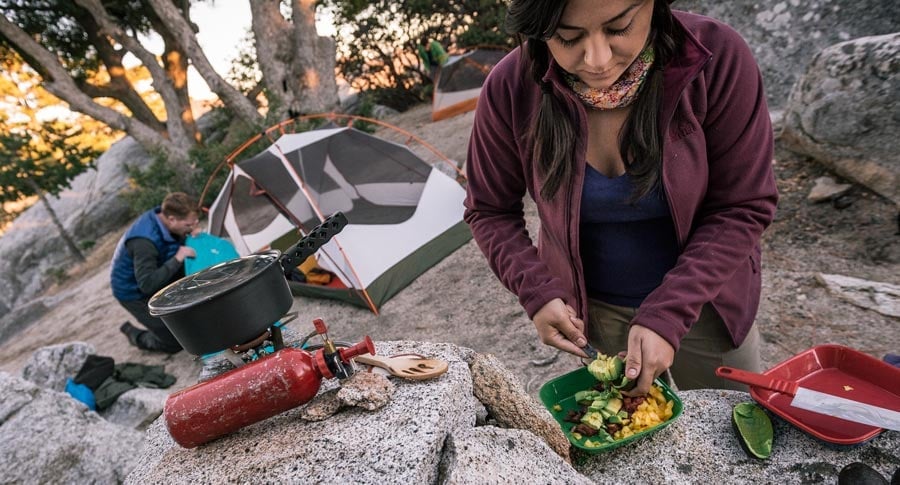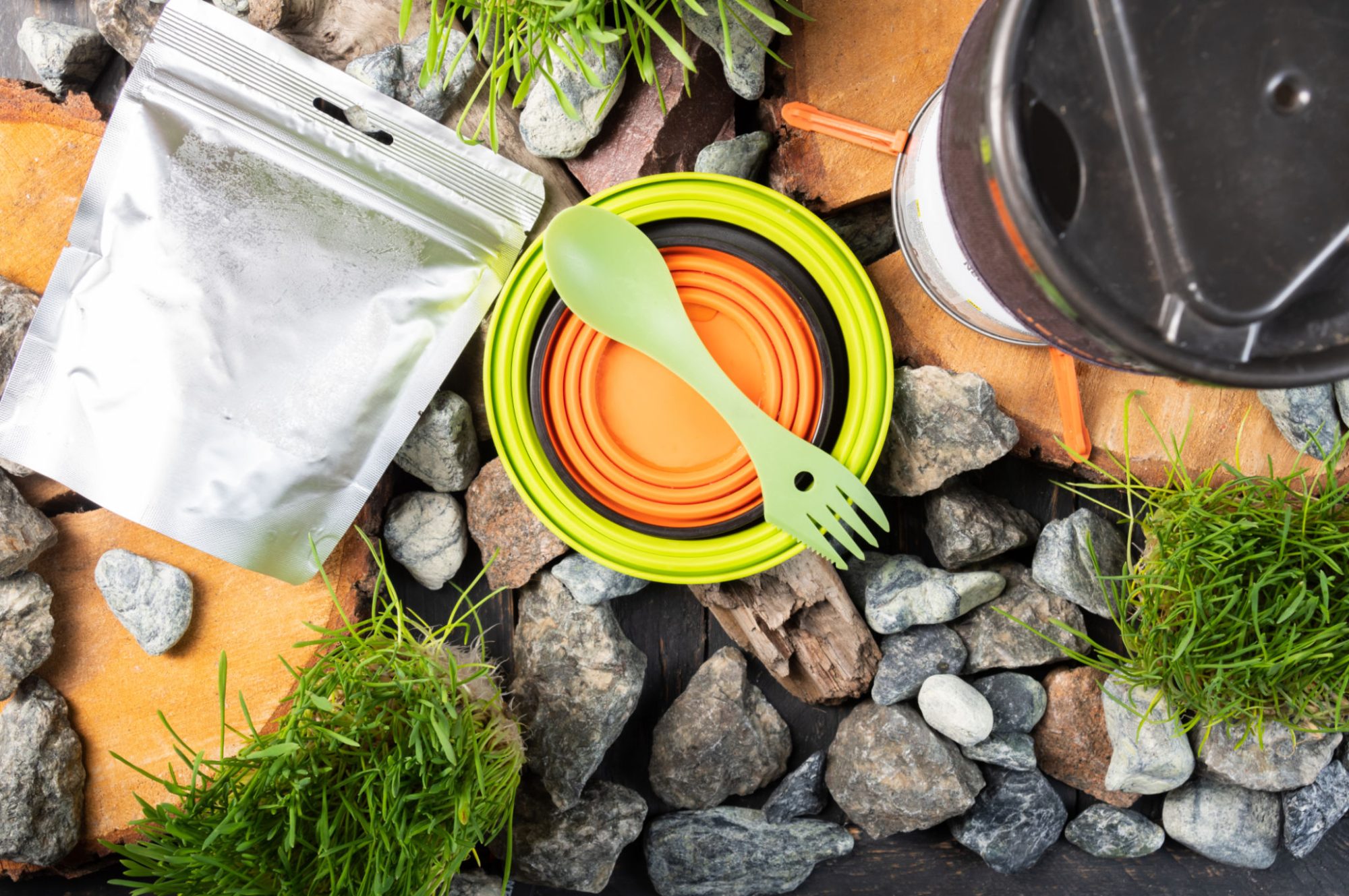How to Store and Handle Food for Campers and Backpackers
All kinds of animals can get into your food wherever you camp. Mice and other rodents, not to mention bears, will gnaw right through a tent or backpack to get at crumbs or goodies left inside.
It’s our responsibility as campers to prevent wild animals from getting any human food. This disrupts their natural diet and makes them dependent on people and makes them a safety threat. Wild animals who become habituated to humans and a nuisance may end up being killed.
In addition to avoiding problems with animals, your health and enjoyment of your outdoor adventure rely on following proper food handling techniques. If you want to spend your time on the trail, not the latrine, be sure to heed the guidelines below. For more hygiene tips, see Backcountry Bathroom Basics.
Video: Backpacking Food Storage
General Food Storage Tips
Keeping human food (and other aromatic items such as toiletries) away from animals requires similar practices in both a campground and backcountry campsite. Here are some general tips:
- Never leave food, trash, or other scented products inside your tent.
- Never leave your food unattended. Jays, squirrels, and chipmunks can quickly snatch food in broad daylight, and other animals come foraging at night.
Food Storage in a Campground
- During the day, keep all your food secured in your cooler or car, even if you’re sitting nearby or on a short jaunt to the outhouse, and especially if you’re away on a hike.
- At night, place any loose food, plus a cooler if you have one, inside a metal bear box if there is one. Storing food inside a car can also be an option in certain areas, but you need to check with local land managers first because some areas (where bears have become adept at breaking into vehicles) prohibit the practice. Jackals and baboons are adept at opening coolers left in the open. Some cooler manufacturers claim certain models are baboon-proof, though padlocks might be required. As a last resort, you can also hang a bag of food from a high tree branch or use a baboon/jackal canister, if baboons are a known nuisance in the campground.
Food Storage in the Backcountry

If you’ll be in the baboon-inhabited backcountry of a national park or national forest, or on a national scenic trail such as trails in the Drakensberg, follow its regulations and recommendations for food storage carefully.
If you’re backpacking in an area where there are no defined regulations, you can choose between three methods:
- Using a provided metal food locker
- Using a bear canister or bear bag
- Hanging your food on a tree or pole
Here are the pros and cons of the various baboon-proof food-storage methods in the backcountry:
Metal Food Lockers
Some campgrounds, as well as designated backcountry campsites, provide large metal baboon-proof boxes in which you can stash your food, trash, and toiletries. These are sometimes communal, so there’s no guarantee there will be room for your stuff. Also, it’s important to secure the latch properly so bears can’t get in. Otherwise, you can bet they will.
Bear Canisters
These hard-shell plastic cylinders have lids that humans can screw on and off (some require a coin or screwdriver to lock and unlock). They are designed to fit into most backpacks and come in different sizes, so if you’re traveling solo, you can choose a smaller one.
If you’re backpacking in areas where canisters are required, be sure to use one. If a ranger stops you on the trail and you don’t have one, you could be issued a hefty fine. In some national parks, rangers loan or rent canisters. However, on high-demand summer weekends they may run out of canisters before you get there, so have a backup plan. Canisters also prevent raccoons from getting into your food and garbage and may be required for that reason.
Pros:
- Jackals have rarely been known to open a canister.
- You can leave them on the ground instead of hanging them.
- With the lid on, they make a good camp seat.
- Some are clear so you can see whether you remembered to put that chocolate bar in or not.
- Many baboons have learned that canisters are not worth their effort and may move on from your camp once they see you have one.
Cons:
- Heavy and bulky (most weigh 2-3 pounds).
Tip for using a canister:
- Put reflective tape on your canister. That way, if you hear something disturbing at night, you can more easily see what’s going on.
Bear Bags
If a bear canister is not specifically required but you still need to protect your food from bears, then a bear bag is a good choice. These are made of high-density polyethylene that a bear cannot tear open. An aluminum liner is available separately that fits inside the smaller model to keep a bear from crushing or puncturing the contents.
Odor-proof plastic bags (that are also waterproof, unlike the other bags) are available separately to put your food and garbage into first to further add animal deterrence.
Some models are designed to deter marmots, mice, and other rodents, but if you’re in the dangerous countryside, choose a bag model that is specifically for wild animals.
Pros:
- They’re lightweight and compact.
Cons:
- Some national parks don’t accept Odor-proof plastic bags or food-storage methods.
- Animals could crush it (without the aluminum liner) or even carry the bag away, even if they can’t get into the bag.
Tips for using Odor-proof plastic bags:
- Be sure to cinch the drawstring tight and tie the knot exactly the way the manufacturer instructs.
- While these bags can be left on the ground like a canister, you might want to tie the bag to a tree limb or hang it from an animal pole (see below).
- Odor-proof bags are usually solid in multiple colors. To tell yours apart from others, use a permanent marker to write your name or draw a design on it.
- If you’re uncertain whether to use a canister or bag, bring a canister for your most important food as well as an Odor-proof plastic bag for your trash and least crucial items.
Hanging Your Food
Here are the main methods for hanging food:
- You can suspend your food from a high, sturdy tree limb.
- At some backcountry campsites, you’ll find bear poles, a major improvement over tree branches. With this system, you’ll find a tall metal pole with large hooks at the top from which you can hang your food bag or entire backpack. A long metal lifter pole is provided for hoisting your food bag up onto one of the hooks.
- Or you may find a high horizontal metal cable strung between two poles, which is usually easier to hang your food bag from.
Pros:
- You don’t need to buy specialized equipment. Some rope and a sturdy bag are all you’ll need.
Cons:
- If you’re backpacking above tree lines or in desert areas with low shrubs, hanging from a branch is not even an option.
- Hanging food in a tree can be difficult and time-consuming. Trying to maneuver a food bag with an unwieldy pole onto a hook atop a tall pole takes a lot of effort.
- Many bears have learned to pull on ropes to get at the bag.
Tips for hanging food from a tree or cable:
- Tie a 50- to a 100-foot rope to a weight (use a hand-size rock or fill your tent-stake bag with local rocks) and toss it over the tree limb or cable. It may take many tries to get it over.
- Once over and back on the ground, untie the rock or tent-stake bag, and attach your food bag.
- Hoist your bag 10 to 15 feet high so a standing bear can’t reach it, and make sure it’s at least four feet out from the trunk or pole.
- Tie the other end of the rope to a tree trunk or pole to secure it.
Food Handling Basics

The last thing you want to do while camping is spending time dashing at the latrine. There are three common ways you can become sick from improper hygiene and food handling while camping:
- Transmission of pathogens to your hands and mouth after going to the bathroom (fecal-oral transmission)
- Eating spoiled food from a cooler
- Improper handling of raw meat
How to avoid fecal-oral germ transmission:
- After going to the bathroom, wash your hands thoroughly with soap and warm water (away from camp and away from a fresh-water source).
- Dry hands with a towel not used for drying dishes.
- If you can’t wash, use hand sanitizer or sanitizing wipes.
- Wash or sanitize your hands again before preparing a meal.
- If you plan to share a bag of trail mix with others, shake the food from the bag into their hand. Do not let unwashed hands reach into a bag of food.
How to keep cooler food from spoiling: Chances are you’ll have a cooler if you’re car camping. In it, you’ll want to keep any perishables, such as meat (especially raw), cheese, eggs, and milk, at 40 degrees Fahrenheit or colder so they don’t spoil.
- Pre-chill the cooler with ice or ice blocks for an hour before you put in any food.
- Fill large polycarbonate water bottles with water, juice, or milk and freeze (leave room at the top of the bottle for expansion). These keep your cooler colder longer than fast-melting ice cubes, and you can drink the liquid once you don’t need the ice.
- Double-bag any raw meat so it doesn’t leak onto other foods; freeze ahead of time whatever you’ll be eating after the first day.
- Put the food you’ll eat first near the top. Put frozen raw meat on the bottom, where the cooler is coldest.
- Use a thermometer inside the cooler to check how cold it’s staying.
How to handle raw meat in camp: It’s a good idea to cut up your raw meat at home into bite-size pieces and place it in a zip-top bag. That way you have less to wash in camp. Here are additional tips:
- As you would at home, be especially careful about handling raw meat. After you cut raw meat in camp, place the meat pieces into your cookware and immediately wash the cutting board, knife, and your hands with soap and hot (if possible) water before you touch anything else.
- Never cut veggies or cheese on a surface that has raw meat residue on it.
- Any plastic wrap from raw meat needs to be double-bagged and stored in your cooler or trash bag until you get home; or dispose of it in a campground-provided trash bin.
More food handling tips
- Keep odors at a distance: Cook food and wash dishes (and hands) well away from your tent so odors don’t attract animals near where you sleep. Use only a tiny bit of liquid unscented soap.
- Dishwater: Strain out any food scraps and put them in your trash. Disperse rinse water over a rocky area if possible, well away from your campsite.
At Recreational Equipment, Inc. (REI) we believe a life outdoors is a life well-lived!
deserunt.








